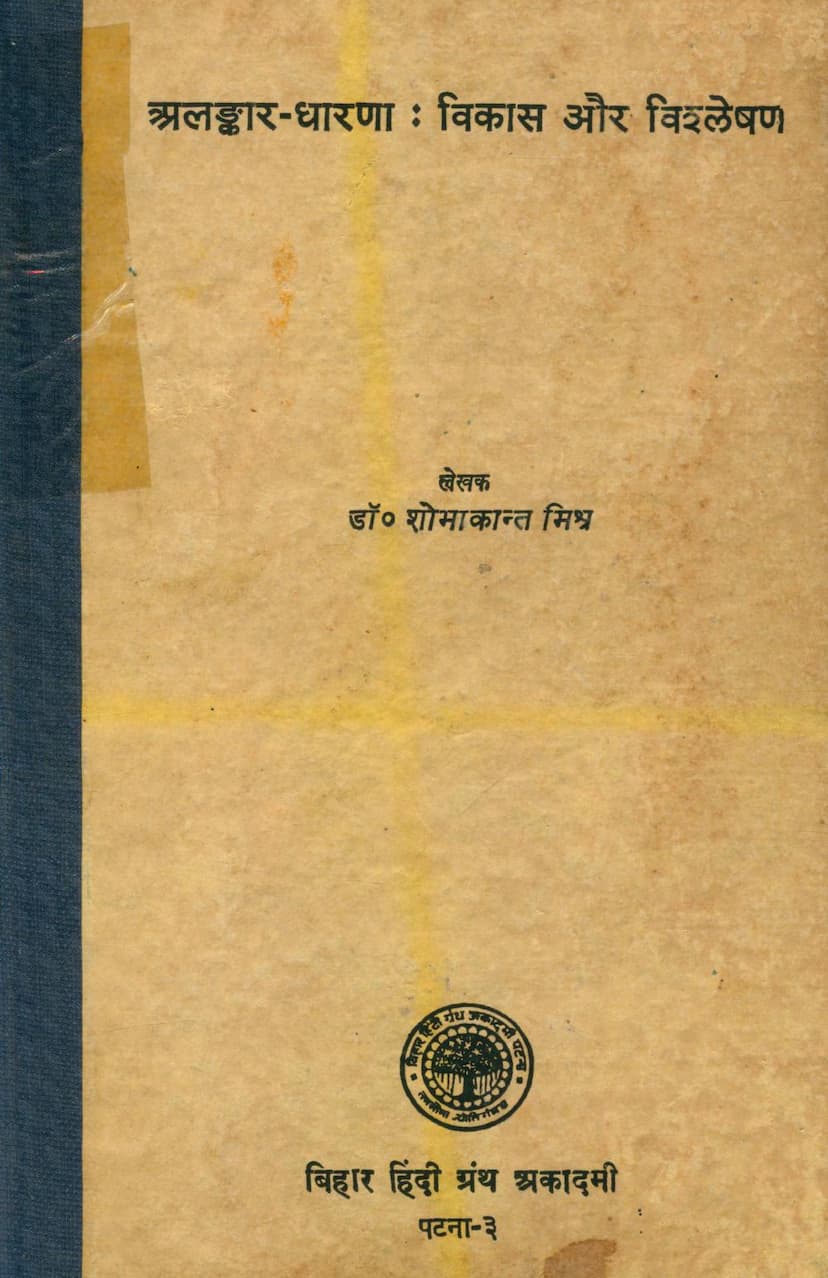Alankar Dharna Vikas Aur Vishleshan
Added to library: September 1, 2025

Summary
Here's a comprehensive summary of the Jain text "Alankar Dharna Vikas aur Vishleshan" by Shobhakant Mishra, based on the provided pages:
Book Title: Alankar Dharna Vikas aur Vishleshan (Concept of Rhetoric: Development and Analysis) Author: Dr. Shobhakant Mishra Publisher: Bihar Hindi Granth Academy, Patna
Overview:
This book is a scholarly exploration of "Alankar" (rhetorical devices or figures of speech) within Indian poetics (Kavya Shastra). It delves into the concept of Alankar, its evolution throughout different periods of Indian literary thought, and its analysis in relation to other poetic elements. The author aims to provide a comprehensive understanding of Alankar for postgraduate students, research scholars, and professors.
Key Themes and Chapters:
The book is structured into eight chapters, each focusing on a distinct aspect of Alankar:
-
Chapter 1: The Nature of Alankar and its Place in Poetry:
- Defines Alankar as a means to enhance poetic beauty and impact.
- Discusses the diverse views of various scholars on whether Alankar is an inherent (internal) or external aspect of poetry.
- Explores the debate on whether Alankar is integral to poetic beauty or merely an additive element.
- Addresses the relationship between Alankar and Alankarya (the decorated object), analyzing whether they are distinct or indistinguishable.
- Compares Indian and Western philosophical perspectives on aesthetic adornment.
-
Chapter 2: The Development of the Concept of Alankar:
- Traces the historical evolution of Alankar, starting from the limited recognition in Bharata Muni's Natya Shastra (only four Alankars).
- Highlights the significant increase in the number of recognized Alankars over time, reaching nearly two hundred in Sanskrit poetics and about twenty new ones in Hindi Riti literature.
- Examines the reasons behind this proliferation, including the development of Lakshanas (definitions) that sometimes evolved into independent Alankars.
- Discusses theories, like Bhatt Tauta's and Abhinavagupta's, suggesting that all Alankars are essentially extensions or variations of the fundamental concept of Upama (simile).
- Explores how concepts from philosophy (like memory, illusion, doubt) and logic (proofs) were integrated into the study of Alankar.
- Acknowledges the role of poets' creativity in inventing new Alankars.
- Critiques the simplistic view that Bharata's limited number of Alankars indicates an underdeveloped concept, arguing for the context of his Lakshana theory.
-
Chapter 3: Innovations in Alankar in Hindi Riti Literature and their Sources:
- Focuses on the unique contributions of Hindi poets and theorists in the Riti period.
- Aims to clarify misconceptions surrounding these innovations.
- Analyzes the sources of these new Alankars, often found in earlier Sanskrit traditions or philosophical concepts.
-
Chapter 4: Classification of Alankars:
- Presents a classification system for all acceptable Alankars.
- Reviews existing classifications by Sanskrit and Hindi scholars based on word (Shabdalankar), meaning (Arthalankar), and both (Ubhayalankar).
- Discusses attempts to categorize Arthalankars based on their fundamental principles.
- Critiques the limitations of previous classifications, which often focused only on the Alankars recognized by specific theorists.
- Proposes a comprehensive classification based on existing logical frameworks, incorporating new categories where necessary.
- Emphasizes that a single Alankar can fit into multiple categories depending on the perspective.
-
Chapter 5: Development of the Form of Individual Alankars:
- Studies the evolution of the form and definition of each specific Alankar.
- Examines the differing interpretations and formulations of individual Alankars by various Sanskrit and Hindi scholars.
- Provides a critical analysis of these varying viewpoints.
-
Chapter 6: Classical Analysis of the Distinctions Between Similar Alankars:
- Addresses the need for differentiating Alankars with similar forms and functions.
- Highlights how the proliferation of Alankars led to subtle distinctions and the necessity of clarifying their unique characteristics.
- Explains how scholars identified the distinct features (vyavartak dharma) of each Alankar to establish these differences.
-
Chapter 7: The Nature and Function of Alankar from a Linguistic Perspective:
- Considers the role of Alankars in enhancing the impact of language, not just in poetry but also in everyday speech.
- Argues that Alankaric usage can sometimes be essential for conveying meaning effectively.
- Emphasizes the linguistic importance of studying Alankars independently.
-
Chapter 8: The Relationship Between Alankar and Emotion (Manobhav):
- Discusses how some Alankars are directly linked to emotions (like joy, sorrow).
- Explains how most Alankars, while related to words and meanings, indirectly influence emotions.
- Considers the impact of every stylistic variation on the human mind.
Key Arguments and Contributions:
- Alankar as Integral: The book argues that Alankars are not mere external decorations but can be internal components of expression, so much so that their removal might fundamentally alter or destroy the utterance.
- Evolutionary Perspective: It provides a detailed historical account of how the concept and number of Alankars evolved from Bharata's time onwards, influenced by the development of Lakshanas and the absorption of concepts from other fields.
- Source Analysis: The author diligently traces the origins of various Alankars, linking many later developments back to Bharata's foundational Lakshanas and analyzing how they were reinterpreted or combined.
- Critical Evaluation: The book engages in critical analysis of different scholarly viewpoints on Alankars, evaluating their strengths and weaknesses.
- Classification System: It proposes a comprehensive classification system for Alankars, aiming to address the limitations of previous attempts.
- Linguistic and Psychological Aspects: The author considers the linguistic function of Alankars and their impact on human emotion, demonstrating a multi-faceted approach.
Overall Significance:
"Alankar Dharna Vikas aur Vishleshan" is presented as a foundational text for understanding the intricacies of Alankar in Indian literary tradition. It offers a structured approach to a complex subject, tracing its historical trajectory and providing analytical insights. The book's publication under the Bihar Hindi Granth Academy, with government funding, signifies its importance as a standard academic work for higher education.
This summary covers the main points presented in the provided pages, focusing on the book's scope, structure, and the author's approach to the subject of Alankar.